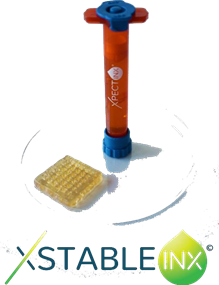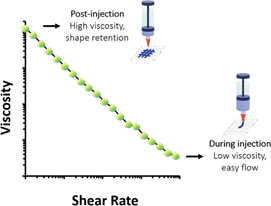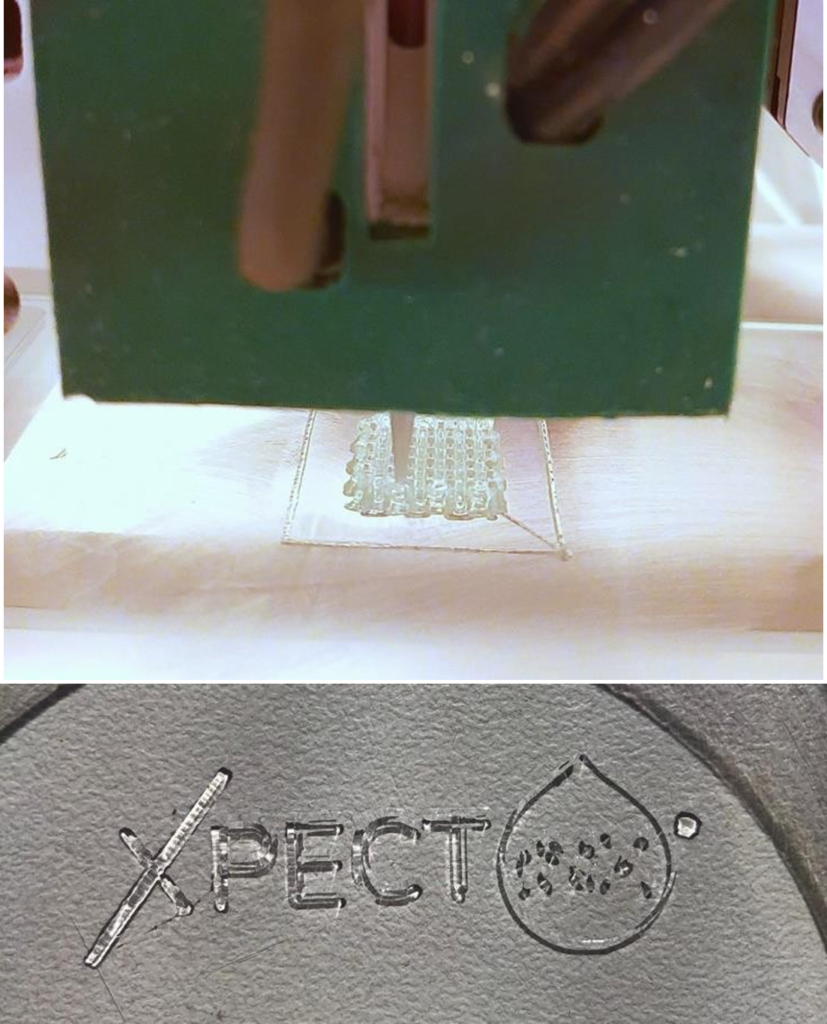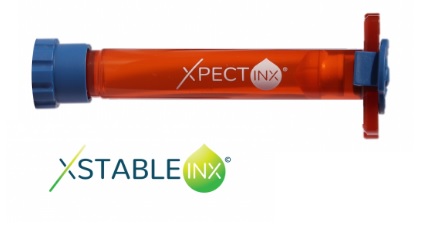“Stability for Long Lasting Support.”

Introduction
X Stable INX© is a synthetic shear thinning, cell-interactive scaffold ink. X Stable INX allows an easy printing process thanks to its shear thinning behavior, as schematically presented in Figure 1a. At high shear rates, it exhibits a low viscosity which is favorable for an easy injection from the printing nozzle. However, at low shear rates it reveals a high viscosity, which is required for shape retention after deposition.

Figure 1: Typical flow curve for a shear thinning fluid: A decreasing viscosity profile as a function of shear rate indicates a shear-thinning behavior
X Stable INX is cell interactive and non-biodegradable. Therefore, it can provide long lasting support to the cells. After photo-crosslinking, a flexible yet strong hydrogel is obtained.
Physical Characteristics
X Stable INX is a transparent gel at room temperature. The physical characteristics of X Stable INX is listed in the table below.
| Properties | Unit | Result |
| pH | – | 7.5 – 9.5 |
| viscosity (γ= 0.01 s-1) | Pa.s | 3500 |
| viscosity (γ= 554 s-1) | Pa.s | 1.56 |
| Storage Modulus (MPa) | kPa | 150 |
X Stable INX reveals a shear-thinning behavior as shown in Figure 2 (a). This is favorable for extrusion- based 3D printers as the printing ink should easily be injected through the printing nozzle and the post- injection flow should be minimized in order to prevent structural deformation.
To enable an optimal printing process ensuring shape fidelity, an ink should not only exhibit shear- dependent viscosity, but also its viscosity must exhibit a rapid decrease and rapid recovery upon an instant change in the shear conditions. After ejecting from the printing needle, an ink solution should regain quickly its viscosity upon deposition on the printing surface. The rate of viscosity recovery was studied via rotational step shear tests at shear rates of 0.1 s-1, 100s-1 and 0.1 s-1 in the sequential order. As seen in figure 2 (b), X Stable INX exhibits a rapid viscosity recovery, regaining more than 85% of its viscosity after deposition.

Figure 2: (a) Flow curve of X Stable INX as a function of shear rate, (b) viscosity of X Stable INX tested in transient shear rate conditions and (c) storage and loss moduli of X Stable INX recorded via a rheometer during UV irradiation
X Stable INX is photo-crosslinkable, and therefore the structures can be illuminated with UV irradiation during or after printing process. Prior to UV irradiation, the ink exhibits a storage modulus higher than its loss modulus, which is characteristic for physical gels (Figure 2 (c)). After switching on the UV light source, the ink reveals a rapid crosslinking process as indicated by the steep increase of storage modulus. At the end of the irradiation process, the ink reached a storage modulus of approximately 150 kPa.
Biological performance
The X STABLE INX© material combines mechanical integrity with biocompatibility making it suitable for load bearing tissues. To this end already successful experiments were performed for bone and skin tissue (Figure 3).

Figure 3: Different validated cell types on X STABLE INX©
Key Properties
- Cell interactive: allows for cell adhesion
- Biostable: non-biodegradable making it suitable for long term support
- Easy processing: shear thinning behavior enables straightforward printing
- Mechanical integrity: very robust hydrogel allowing easy handling
- Reproducibility: Produced under strict quality control
Key Benefits

Table 2: Key benefits of X STABLE INX in comparison to conventional bioinks

Figure 4: Examples of printed structures
| Number | Category | Product | Amount |
|---|---|---|---|
| 1 | - | X-Stable-INX | 1 |

